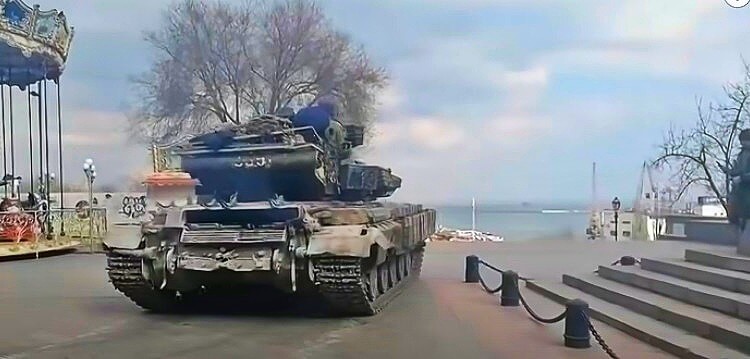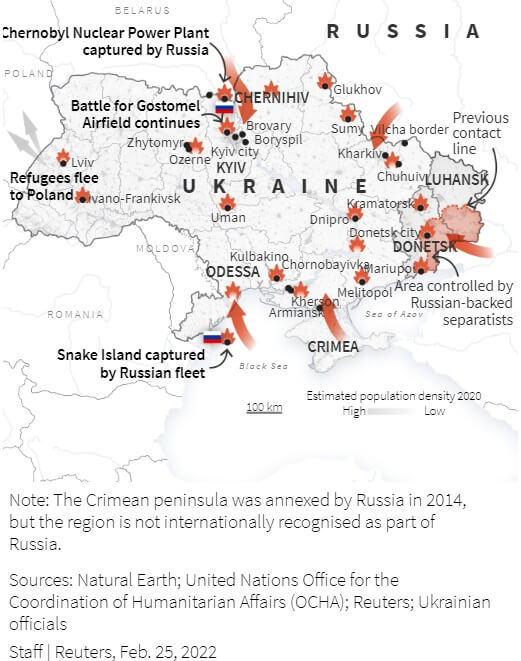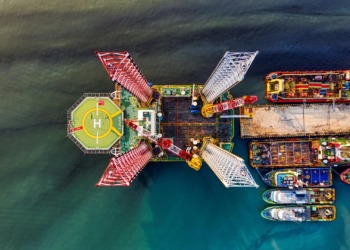The question on everyone’s mind is, now that the Russian army – those 150,000 troops Putin has spent months amassing on Ukraine’s borders – has entered Ukraine, what happens next? Can the Russians take control of the capital city Kyiv and other city centers or will it degenerate into a long drawn-out urban guerilla?
Fighting in the streets and in the fields and forests
Ukraine President Zelensky, when the Russian invasion started before dawn on February 24, was quick to declare martial law and started to arm the population, distributing weapons to all citizens who asked for them. Add that number to Ukraine’s regular army, and you have, according to military observers, some 900,000 people up in arms and ready to defend their country. And on all accounts, Ukrainians are worked up, angry at Putin and Russia and ready to fight.
The numbers are not particularly in favor of the Ukrainian army, it’s a matter of David against Goliath – although, as I will show, Ukraine is not really such a small David after all.
The biggest difference is in the amount of money devoted to defense: The Russian defense budget is ten times Ukraine’s. Although Ukraine did triple its budget in real terms over the last decade and total defense expenditures in 2020 amounted to $4.3 billion.
Since 2014, when the Ukrainian army lost Crimea because it could barely fight, things have changed.
First, Ukrainian forces have been gaining combat experience in the Donbas, fighting the separatists since 2014.
Second, after a slow start, Ukraine began receiving considerable help from the West. In fact, Ukraine for several years could not obtain top-of-the-range missiles from America: President Obama nixed their sale, as the US military worried at the time that arming Ukraine would hand over technology to Russian spies.
That policy changed in 2017 with the Trump administration that approved supplying Javelin anti-tank missiles to Ukraine while the State Department authorized a sizable export of US-made snipers, ammunition, and accessories. Ukraine also received arms and training from other countries, including the UK, Turkey, several eastern European countries, Balkan states.
The only European country that has ruled out arms deliveries to Ukraine is Germany but it is co-financing a $6-million field hospital and providing training.
Still, according to military analysts, Ukraine’s anti-aircraft and anti-missile defenses remained relatively weak, a fact that clearly emerged over the last two days when Russia successfully bombarded Ukrainian military positions.
With Zelensky coming to power in 2019, efforts have accelerated to strengthen Ukrainian defense. Zelensky recently signed a decree, ordering to increase the size of the forces by 100, 000 by 2025 while ending conscription in 2024. The idea is to operate a gradual transition to a professional army, all of which would eventually bring Ukraine’s armed forces to 361,000 personnel.
For now, Ukrainian forces total 215,000 active personnel (of which 125,000 make up the permanent army) and 220,000 reservists – and as I mentioned above, that figure rises to almost 900,000 taking into account veterans and volunteer defense forces.
This means Ukraine has the largest defensive forces in the region after Russia. According to the London-based International Institute for Strategic Studies (IISS), Russia’s combined armed forces total about 900,000 active-duty military personnel.
Add to that the annoying fact for Putin that his war in Ukraine is not popular in Russia, and the war outlook in Ukraine is not as rosy as he might think.
Russia’s strong point, as pointed out by an Atlantic Council report, is its tank force: its 2,840 battle tanks outnumber Ukraine’s by more than three to one. Not particularly useful in guerilla warfare.
True, one may argue that this war is unthinkable, this is one Slav country against another, but when hatred between brothers and sisters is stirred, there is nothing worse than a civil war. And there’s nothing more devastating than a guerilla-style war fought in the streets and the countryside, with shooters hiding everywhere and Molotov cocktails raining on the invading troops.
In fact, news came in today that Ukraine’s defense ministry called on residents of Kyiv to “make Molotov cocktails” as Russian forces advanced on the capital city. History tells us that such wars are rarely won, as the Soviet empire learned in Afghanistan.
Putin stands warned.
A related question: How likely is the war to expand across Europe, are we on the cusp of World War III? For that to happen, neighboring countries would need to get involved in warfare. The four countries of particular concern are those that are NATO members, Poland, Hungary, Slovakia and Romania. Should they be attacked by Russia, the risk of all-out war across Europe would become very real since those countries enjoy NATO protection, as per Article 5 of the alliance’s treaty.
The Role of NATO: Containment?
Article 5 embodies the principle of “collective defense” that is at the heart of the organization. Created in 1949, NATO was set up by the West, under Washington’s guidance, as a treaty of defense against the Soviet Union. NATO was a principal actor in the Cold War, a confrontation with Moscow that ended with the fall of the Wall of Berlin in 1989.
The Article sets a spirit of solidarity, commits NATO members to protect each other if one is attacked: The attack against one ally is considered as an attack against all allies. In its history, NATO invoked Article 5 only one time so far, after the 9/11 terrorist attacks against the United States.
Commitment to Article 5 is “ironclad” as NATO made crystal clear in its statement yesterday, issued after an emergency meeting of its heads of state and governments. But NATO forces will not move into Ukraine, a non-NATO country – in confirmation of President Biden’s well-known “red line” that no American soldier would set foot in Ukraine.
No doubt Biden’s “red line” is one of the reasons why Putin felt he had a green light to go into Ukraine once the West and NATO had repeatedly rejected his demand that Ukraine not be allowed to join NATO – something Zelensky was openly keen on, earning Putin’s ire.
It’s worth recalling: In September 2020, Zelensky approved Ukraine’s new National Security Strategy, which provided for the development of the distinctive partnership with NATO with the aim of membership in NATO.
The critical passages in the NATO statement are the following.
First, a vigorous condemnation of Russia: “President Putin’s decision to attack Ukraine is a terrible strategic mistake, for which Russia will pay a severe price, both economically and politically, for years to come. Massive and unprecedented sanctions have already been imposed on Russia.” The attack on Ukraine is “entirely unjustified and unprovoked”, a “grave violation of international law” and a “serious threat” to Euro-Atlantic security. The Alliance also condemned Russia’s decision to extend recognition to the separatist regions of eastern Ukraine.
NATO Allies called on Russia to immediately cease its military action and withdraw all its forces from in and around Ukraine.
Something else happened at that meeting yesterday: As underlined in the statement, there was an extension of NATO action to non-NATO members. As it says in the text:
“[we] will continue to coordinate closely with relevant stakeholders and other international organisations including the EU. At the invitation of the Secretary-General, we were joined today by Finland, Sweden and the European Union.” (bold added)
Putin has managed to unite the whole of Europe against him.
And NATO is busy strengthening its forces along its eastern border, as indicated in the statement:
“We are now making significant additional defensive deployments of forces to the eastern part of the Alliance. We will make all deployments necessary to ensure strong and credible deterrence and defence across the Alliance, now and in the future. Our measures are and remain preventive, proportionate and non-escalatory.”
In other words, a military wall is built around Ukraine, entrapping the Russian army. This looks a lot like a containment strategy. NATO may not be moving into Ukraine but it leaves a door open:
We will continue to provide political and practical support to Ukraine as it continues to defend itself and call on others to do the same. We reaffirm our unwavering support for the independence, sovereignty and territorial integrity of Ukraine within its internationally recognised borders, including its territorial waters. This principled position will never change. (bold added)
So Ukraine will be getting “political and practical support” – the word “practical” obviously covers many things, including arms deliveries, training and even less obvious (or legal) forms of support…
There is also another important point made in the above statement. It means that in any future negotiations with Russia, the path is already drawn: Russia will not be allowed to grab pieces of Ukraine. What about the separatist regions? At this point in time, it’s impossible to predict how these contrasting positions will play out. A Crimea-style agreement may be found, who knows.
But one thing is certain, if Putin goes on with his invasion and does not stop for negotiations with Zelensky, he can expect a further tightening of the screws, with suspension from the global SWIFT payments system.
SWIFT stands for “Society for Worldwide Interbank Financial Telecommunication”, a secure messaging system that facilitates rapid cross-border payments, underpinning international trade and finance. That would hurt Putin but also the whole of Russia, its economy would collapse as it would be literally thrown back into the Middle Ages.
Russia would no doubt retaliate by cutting off gas and oil, but it would be like cutting its own nose. Suspension from SWIFT is the nuclear option and it would hurt everyone.- which is why so far German Chancellor Scholz has resisted.
But every day a new country indicates it would consider using it. Friday it was France, Saturday it was Italy and Cyprus that changed their position and indicated support. Central banks are reportedly getting ready for it. How long can Scholz resist?
Not long.
Updated Feb. 27: The US and its allies announced on Saturday that certain Russian banks would be banned from SWIFT in further punishment of Moscow. The actions are aimed at preventing Putin from using $630 billion in central bank foreign currency reserves in the invasion of Ukraine and to defend a plunging rouble. Germany reversed its policies: Chancellor Scholz announced Germany would adhere to the SWIFT ban and send weapons to Ukraine.
Putin, no doubt in reaction to NATO’s statement, has put today his nuclear forces on high alert. But this is yet another mistake. This is not a nuclear war, chances are it will turn into guerilla warfare, another Afghanistan for Russia. This time, unlike in 2014 when he annexed Crimea without a fight, the Ukrainian people are ready for battle like never before.
Editor’s Note: The opinions expressed here by Impakter.com columnists are their own, not those of Impakter.com. — Featured Photo: Russian tank (screenshot from The Economist Video)











